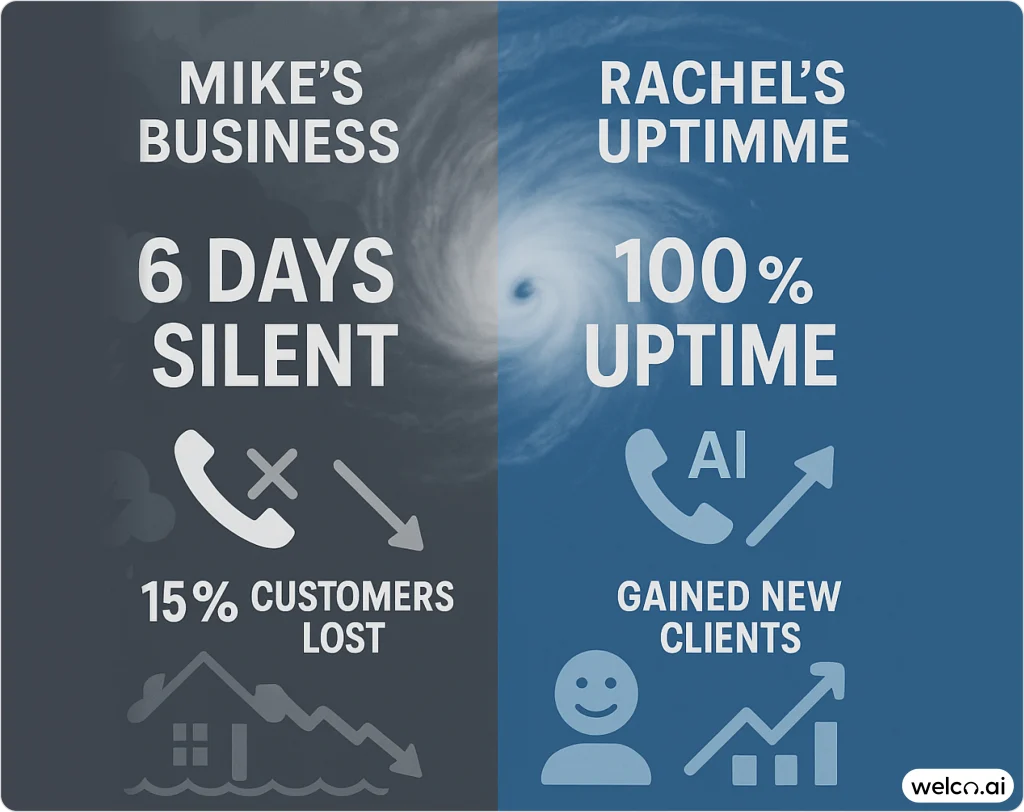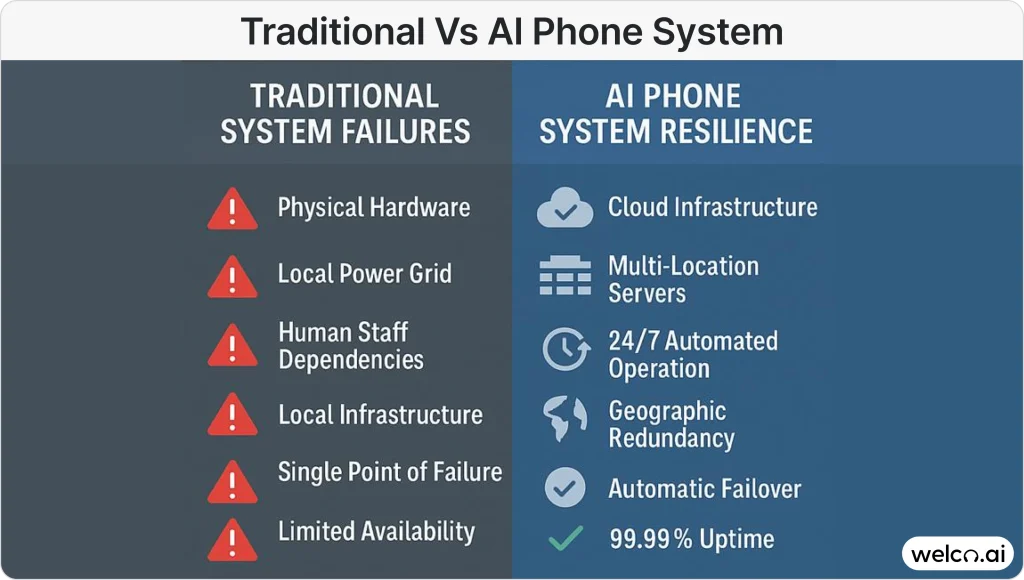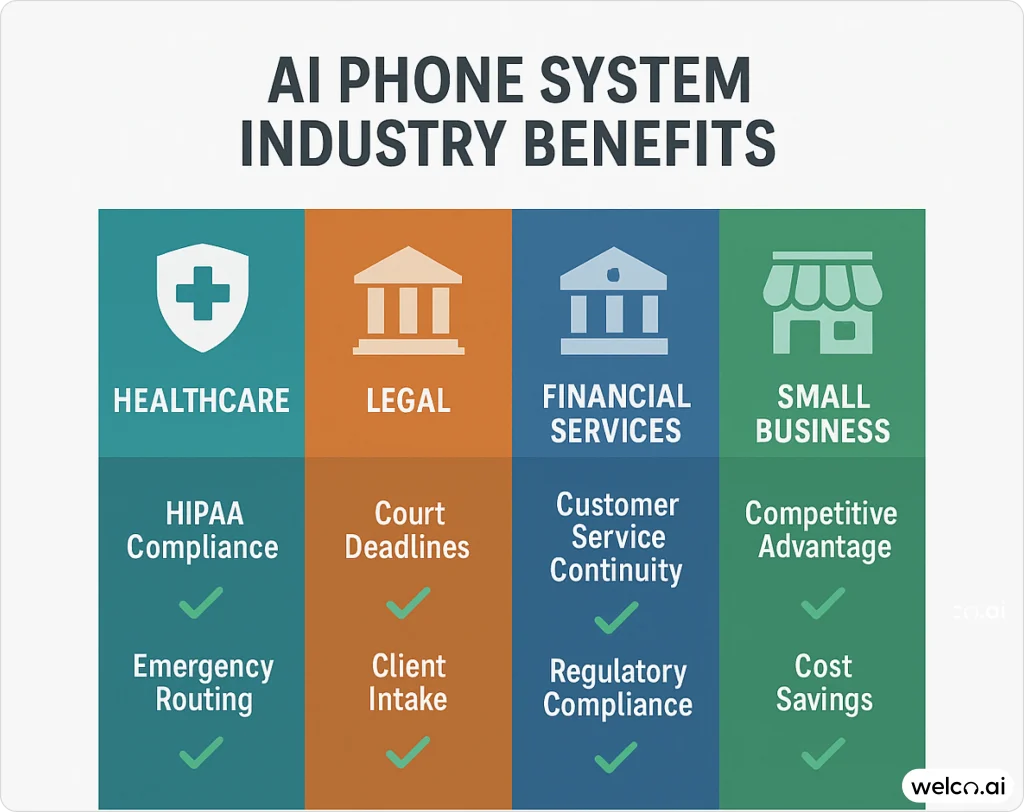The Day Mike Watched His Business Die from His Living Room
Mike watched his business die from his living room. Not from flood damage—from silence.
For six days after Hurricane Ida hit Louisiana in August 2021, his insurance agency’s business phone system was dead. Panicked customers couldn’t reach him when they needed help most. While he sat helplessly watching flood waters recede on the news, his competitors were already capturing his clients.
By the time power returned, 15% of his client base had already moved on.
Three blocks away, attorney Rachel Torres had a completely different experience. While Hurricane Ida knocked out power across the region, her AI phone system kept working, routing calls through servers in Austin. Her “receptionist” was still scheduling closings and fielding frantic calls from buyers whose deals were supposed to close that week.
The difference? Rachel’s phones worked when it mattered most.

Look, I get it. This probably sounds like marketing hype. I thought the same thing until I started digging into what actually happens when businesses lose their lifeline during crises.
The truth is, most business owners don’t realize the hidden costs of traditional phone systems until disaster strikes and exposes every vulnerability at once.
Why Your Phone System Will Abandon You (And You Won’t See It Coming)
Here’s the uncomfortable truth that most business owners don’t realize until it’s too late: when disaster strikes, most callers won’t even bother leaving a voicemail. They’ll just hang up and call your competitor.
Traditional business phone systems fail because they depend on things that break:
- Physical hardware sitting in your office
- Local power grids that go down first
- Human staff who can’t get to work
- Infrastructure that wasn’t built for emergencies
When Hurricane Sandy hit in 2012, the Hagaman Insurance Group learned this lesson the hard way. Their phones went dead for days, and they lost customers—not from storm damage, but from being unreachable when people needed them most.

The real kicker? Every hour of communication downtime costs businesses thousands of dollars. For financial services, we’re talking hundreds of thousands per hour.
I’ve been through enough hurricanes here in Florida to know that when people are scared, they need to hear a human voice—even if it’s an AI that sounds more professional than half the receptionists I’ve met.
How AI Phone Systems Turn Your Competitors’ Disasters into Your Opportunities
While your competitors scramble to post “Sorry, we’re temporarily closed” messages on their websites, imagine being the only business in your industry still answering calls. That’s exactly what happens when you have an AI phone system that doesn’t depend on your local infrastructure.
Here’s what makes the difference:
Your Calls Work Even When Your City Doesn’t
When Ida knocked out power across Louisiana, businesses with AI systems kept running because their calls automatically rerouted to servers hundreds of miles away. No manual intervention needed—it just worked while their owners evacuated.
They Actually Get Stronger Under Pressure
Remember the COVID vaccine rollout chaos? Dr. Emily Chen’s family practice in Phoenix watched their daily calls jump from around 150 to over 800 overnight. Their traditional system crashed repeatedly, leaving frustrated patients on hold or getting busy signals.
An AI phone system would have scaled automatically, handling the surge without breaking a sweat.
They Fix Problems Before You Even Know They Exist
Modern AI phone systems monitor weather forecasts and automatically boost capacity in unaffected regions before storms even arrive. While you’re boarding up windows, your phone system is already preparing for the communication surge that always follows disasters.
The Stories That Prove This Actually Works
Houston Methodist Health System handled thousands of daily calls during peak COVID vaccination efforts—more calls than they’d ever handled while maintaining HIPAA compliance. Without AI, they’d have needed an army of additional staff working around the clock.
Attorney Sarah Martinez (yes, the same one from our opening) continued processing real estate closings throughout Hurricane Ian while her competitors shut down completely. She told me later that watching her office roof get torn off through security cameras while her AI was still booking appointments felt “surreal but incredibly reassuring.”
Regional Trust Bank kept customer service running during a cyberattack that took down their traditional infrastructure. While their IT team fought off hackers, customers never knew anything was wrong—the AI backup system handled everything seamlessly.
But here’s the thing—not every AI implementation works. Johnson & Associates, a law firm in Miami, tried to rush their setup before hurricane season and ended up with an AI that couldn’t understand basic legal terminology. Their clients got frustrated with responses about “criminal law” when they were calling about real estate closings.
This is exactly why proper implementation strategy matters more than the technology itself.
What This Really Means for Different Industries
Let me show you how this plays out across different industries, because the stakes aren’t the same for everyone—and neither are the solutions.

Healthcare: When Lives Depend on Your Phones Working
Picture this: It’s 3 AM, hurricane winds are howling outside, and Mrs. Rodriguez calls about chest pains. Your staff can’t get to the office, but lives depend on your phones working.
Dr. Jennifer Walsh, an ER physician in New Orleans, put it best: “During Katrina, we lost patients not just from the storm, but because they couldn’t reach us for follow-up care. That can’t happen again.”
AI phone systems maintain HIPAA compliance and route emergency calls properly, even when your staff is evacuating their own families.
Legal: When Deals Can’t Wait for Power to Come Back
Attorney Michael Torres learned this during the 2021 Texas freeze. His AI phone system kept tracking court deadline extensions and managed new client intake while he was stuck at home with no electricity. “I closed more deals that week than some of my competitors did all month,” he told me.
Financial Services: When Hackers Don’t Care About Your Recovery Timeline
When Regional Trust Bank faced their cyberattack, branch manager Lisa Chen watched the whole thing unfold from the emergency operations center. “Our customers kept calling for help while our main systems were down. The AI backup meant we could actually help them instead of just taking messages.”
Small Business: David vs. Goliath Protection
Maria Gonzalez runs three family restaurants across Texas. During the 2021 freeze, her AI phone system kept taking orders while major chains in her area shut down completely. “My AI sounded more professional than some of the big corporate call centers,” she laughed. “People started asking if we’d grown into some fancy operation.”
The Implementation Reality Check (Because 70% of AI Projects Fail)
Here’s what separates the success stories from the expensive mistakes:
Weeks 1-2: Figure out what communication downtime actually costs your business. Not just lost sales—think about insurance claims, customer service nightmares, and reputation damage.
Weeks 3-4: Don’t just pick the cheapest vendor. Find one who specializes in crisis scenarios and can show you exactly how their system performed during real disasters.
Month 2: Start small. Test with your key team members before rolling out company-wide. Johnson & Associates skipped this step and paid for it.
Month 3: Train your team thoroughly. The best technology fails if your staff doesn’t know how to use it effectively.
Understanding how to train staff to work effectively with AI is often more critical than the technical setup itself.
Most businesses see payback within 12-24 months, not just from crisis protection but from handling daily operations more efficiently.
The Choice That Defines Your Business Future
Every day you wait, you’re betting your business survival on infrastructure that fails when you need it most.
The 2024 hurricane season has already been more active than predicted. Cyberattacks are happening constantly. Supply chain issues are making traditional phone equipment harder to replace and more expensive to maintain.
But here’s what really gets me: while you’re reading this, forward-thinking businesses are already implementing AI phone systems. They’re gaining advantages that compound with each disruption. When the next crisis hits, they’ll provide superior service while their competitors struggle with dead phone lines.
What If You Can’t Afford It?
I hear this objection a lot, and honestly, it’s the wrong question. The real question is: can you afford to lose 15% of your customers like Mike did?
Small businesses typically see returns within the first year through improved efficiency alone. Crisis protection is almost like getting insurance for free.
And before you think this sounds too complicated for your small business—remember, Maria’s family restaurants figured it out. If you can run a business, you can implement this.
And if you’re thinking “my current system works fine”—that’s exactly what Mike thought too.
The reality is that proper change management separates successful implementations from expensive failures, and most business owners underestimate this human factor entirely.
Your Next Step (Before the Next Storm Hits)
Ready to ensure your business never goes dark during the next crisis?
Schedule a free business continuity assessment to discover exactly how AI phone systems can protect your business while reducing operational costs. Our experts will analyze your current vulnerabilities and design a solution that keeps you connected when others can’t be reached.
Don’t wait for the next major disruption to expose your communication weaknesses. The businesses that thrive in tomorrow’s unpredictable world are implementing AI phone systems today.
Frequently Asked Questions
Will my customers know they’re talking to an AI during a crisis?
Modern AI sounds remarkably natural, and during emergencies, people care more about getting help than who’s providing it. You can always program it to transfer complex issues to available human staff.
What happens if our internet goes down too?
Good AI systems use multiple internet providers and can route through cellular networks. They’re designed to be more resilient than traditional systems, not just different.
How do I know this won’t become obsolete in a few years?
AI technology improves constantly, but the core need—reliable communication during crises—isn’t changing. Most systems update automatically, so you benefit from improvements without starting over.
What if we have very specific industry terminology or processes?
This is exactly why you need proper implementation. AI phone systems can be trained on your specific vocabulary and workflows. Rush the setup (like Johnson & Associates did) and you’ll regret it.
What’s the real cost?
Small businesses typically see 3-8x ROI over five years. Most achieve payback within 12-24 months through improved efficiency and crisis protection. For a complete breakdown of how to measure AI receptionist ROI correctly, including revenue recovery that most businesses miss, the numbers often exceed initial projections.
Can it really handle our busiest days without human backup?
The best implementations use AI to handle routine calls and route complex issues to humans. During crises, it ensures someone always answers while your staff focuses on the most critical situations. For businesses with multiple locations, scaling AI reception properly can maintain consistency across all sites while reducing overall operational complexity.
